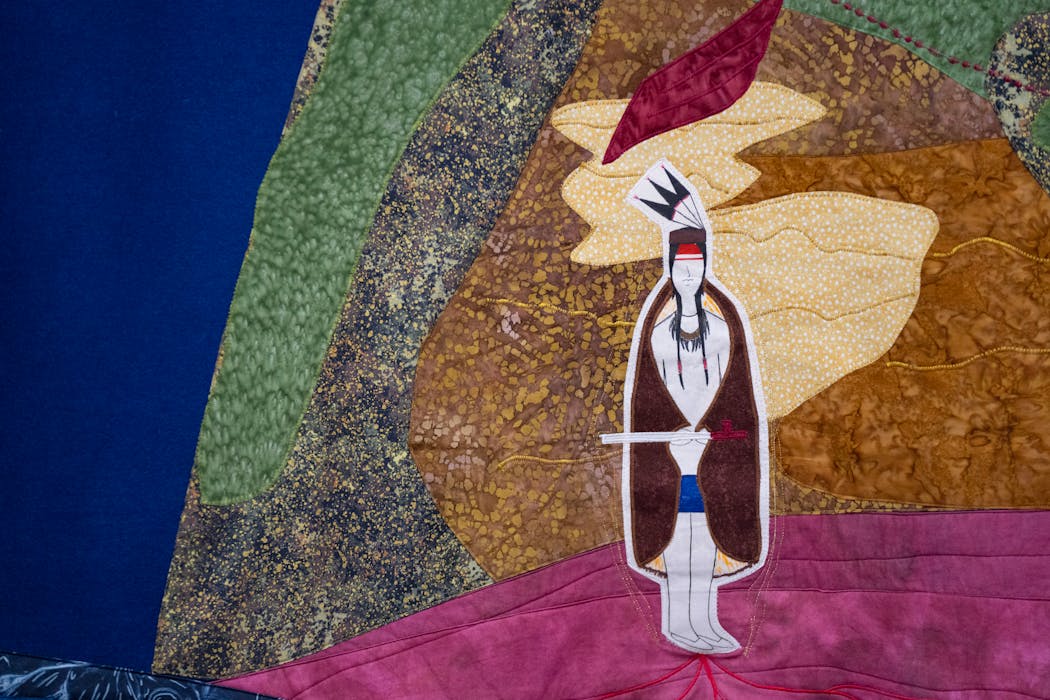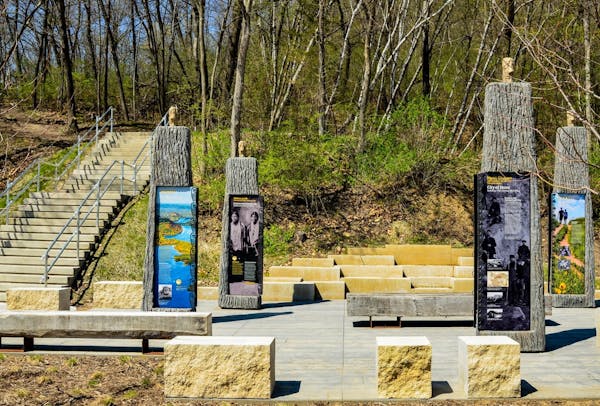RED WING - In decades past, businesses in this city had storefront signs banning Native Americans from entering.
Today, Red Wing businesses are planning to partner with Dakota entrepreneurs to grow the area.
Red Wing Downtown Main Street, Red Wing's economic development agency, is spurring renewed conversations with nearby Prairie Island Indian Community. The groups met Wednesday for a public presentation on area Dakota history and the unveiling of a new art installation that will one day sit in Red Wing's City Hall.
"It's exciting they want to learn about a history that they weren't taught about and we weren't taught about," said Shelley Buck, vice president of the Prairie Island Tribal Council.
The partnership comes after a yearlong diversity project showed how separated the city, named for a famous Dakota chief, had become from its Native American neighbors.
"It became very clear that we had some work to do," Megan Tsui of Red Wing Downtown Main Street said. "Not everyone feels welcome here."
One of the key realizations was how important Treasure Island is to Red Wing's economy. Market research showed most people who attend concerts or shows at the resort and casino eat or stay in Red Wing, which surprised local officials who thought money spent at the casino stayed in Prairie Island.
The tribe generates close to $19 million in state and federal taxes annually along with more than $60 million spent with Minnesota businesses each year, Buck said.
City and tribal officials hope to pool their resources for future projects, including expanded housing developments and business growth for entrepreneurs of color.
Tsui said Downtown Main Street plans to create a paid advisory committee to help would-be business owners overcome obstacles to help fill downtown needs.
The agency also plans to adopt a more long-range attitude toward community planning, similar to Prairie Island's "seven-generation" philosophy where leaders look at how community decisions will affect the tribe's descendants.
Buck said she's cautiously optimistic about the new partnership and the possibility of reconciliation, as it will take time to build trust given the history of bad relations between the area's Native American population and the U.S. government.
Overcoming past injuries
Prairie Island was formally recognized as a reservation in 1889 following decades of settlers stealing or swindling land from Native Americans. Much of the reservation is within Red Wing's city limits.
In the 1830s, Chief Wabasha II helped to negotiate more than 320,000 acres of land between Red Wing and Wabasha for Dakota residents of mixed race.
Those residents were given contracts for 640 acres of land within the tract, but then-Sen. Henry Rice spurred the U.S. Senate in 1854 to offer a new deal — Dakota people could give up their contracts for the land in exchange for an equal amount of property in unsurveyed federal lands.
Traders and settlers took advantage of the Senate deal to con Dakota people out of their property, using the contracts for land in northern Minnesota's mining territory and Nevada, among other parts of the United States.
That's one of a number of historical wounds Buck said the Dakota carry to this day. Buck encourages Red Wing officials to reach out to Prairie Island's council as much as possible to avoid future controversies.
"If you have us at a seat of the table in the beginning, you prevent more work for yourself later on," Buck said.
The city is already taking steps to recognize the impact Prairie Island has had. Cole Redhorse Taylor, a Prairie Island artist, recently designed a tapestry depicting Red Wing's founding.
The piece, called "In the Beginning: He Mni Can," shows Chief Red Wing with a sacred pipe at He Mni Can (pronounced heh-meh-NEE-cha), the sacred bluffs in Red Wing — also known as Barn Bluff — pondering how starting a village near the site would affect his people.
"In the Beginning" will be hung at various businesses around the downtown area before making its way to Red Wing City Hall, where it will go on display next to a portrait of Chief Red Wing.
"It's about offering good feelings and offering a peaceful solution to a lot of these really hard experiences we've all had," Redhorse Taylor said.

Want to share info with the Star Tribune? How to do it securely

'Safe recovery sites' would offer syringes, naloxone and more to people using drugs. The plan could be in peril.
New Minnesota GOP leaders seek peace with party's anti-establishment wing

Who is Republican Lisa Demuth, Minnesota's first House speaker of color?




